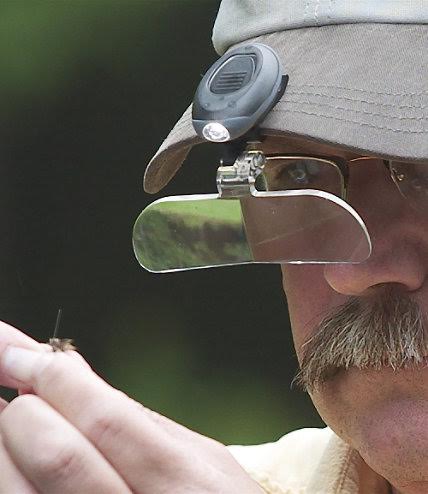 Eyes and age do not go together well! As we age, tying fishing knots becomes a challenge. Whether it is an astigmatism, glaucoma, or just plain “old man’s eyes”, seeing the fine tippets, hook eyes, lures, and flies, just gets tougher.
Eyes and age do not go together well! As we age, tying fishing knots becomes a challenge. Whether it is an astigmatism, glaucoma, or just plain “old man’s eyes”, seeing the fine tippets, hook eyes, lures, and flies, just gets tougher.
“Cheaters” or “bifocals” will solve many of our seeing issues. Wearing them just doesn’t go well with our cool hats, manly or womanly look, or our place in the younger fishing crowds. Our egos prevent us from some simple solutions.
Get over it! If you want to catch fish, you must be able to see and tie a decent knot. There are two primary knots to know. The “Clinch knot” and the “Blood knot” will serve most of your needs for monofilament. Other types of specialized lines require more specific knots for that product.
A “Clinch knot” is the standard connection for fishing line to a hook or lure. An “Improved Clinch knot” adds one more pass through of the line to add strength. The “Blood knot” is for a line to line end connection. It serves fly fishermen well when they use tippets and droppers.
To tie a proper knot, you need to see well enough to thread a fine clear line through a hook eye or gap in the knot. The rest of the tying process can be instinctive. Practice tying the knots with larger line, cord or yarn. Train your mind to see the knot so you completely understand how it works.
Here are some tying tips! Use line clippers instead of your teeth when cutting fishing line. Teeth smash and break the line leaving a wide and rough end. This gnarly end becomes bigger and more difficult to thread through a hook eye. Sharp clippers will make a clean snip that keeps the line end perfectly round and much easier to thread.
Watch a video on how to tie a knot. Goggle “How to tie fishing knots.”, and you will be amazed at how many sites offer great instructions.
Spit helps! A bit of moisture allows you to control the line as you wrap and manipulate it. Wetting the knot before you snatch it tight is also important. Heat, from friction, will weaken the knot. The moisture reduces friction and keeps the knot as strong as possible.
The knot is the weakest part of your fishing line. In line knots, nicks, and abrasions will also weaken the line strength. Routine inspection and maintenance are essential. Many fishermen lose the “big one” because of these preventable problems.
Practice will help you to save time. The more time you waste tying a knot, the less fish you will catch. It is amazing to watch ‘Knot Challenged” fishermen waste so much fishing time. Add some wind, rain, or cold, and tying knots can become even more difficult. Pre -rigging or prepping your knots ahead of time saves time. Using multiple hooked rigs can be made at home and neatly coiled on a small card and inserted into a small plastic bag. Now you need only tie one knot to attach a new rig.
Tie one on quickly and properly!
Montana Grant
For more Montana Grant, visit his website at www.montanagrantfishing.com.